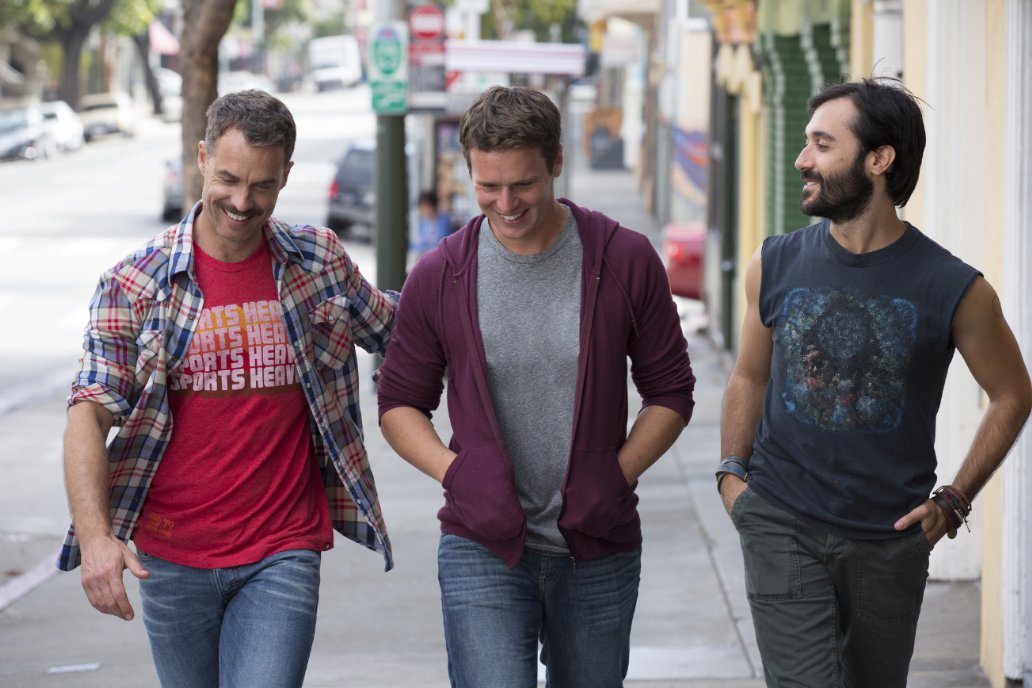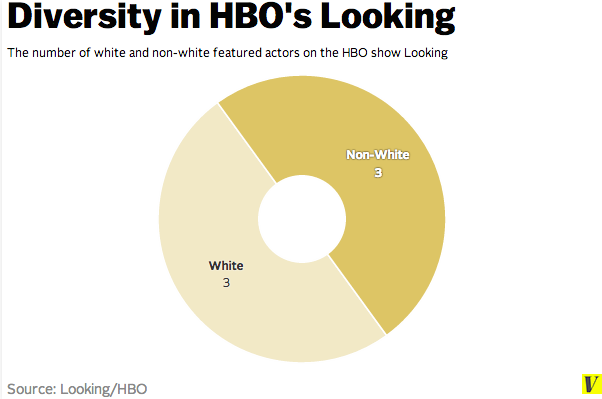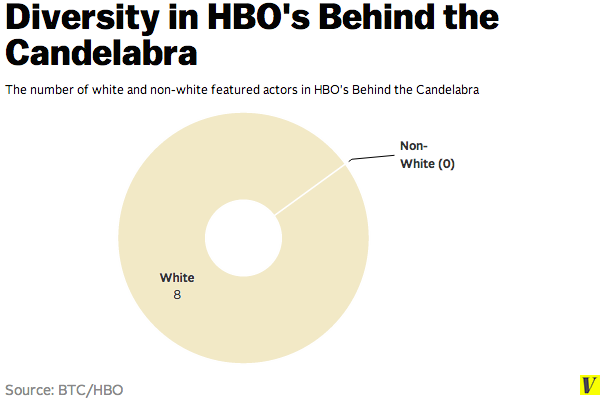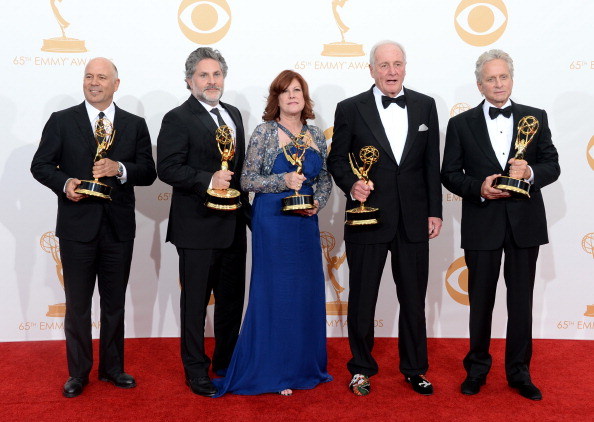/cdn.vox-cdn.com/uploads/chorus_image/image/35107854/MV5BNzkwNDkwNjE4MF5BMl5BanBnXkFtZTgwOTI0MDU4MTE_._V1__SX1304_SY689_.0.jpg)
From single dads (Sean Saves the World), to couples looking to have a child (The New Normal), to celebrities (Behind the Candelabra), to single dorks (Looking) to heroes during the nation's AIDS crisis (The Normal Heart) , there have been a slew of gay characters on television and in movies in the last couple of years.

A still from HBO's Looking
These characters have shown people that gay parents are just like any other parents, that gay men are just like any other men, and that gay people are just as imperfect as their straight counterparts. But if your knowledge about gay life and the gay rights movement came solely from television and movies, you might think that the only people fighting the good fight are good-looking, affluent gay white men and their good-looking, affluent white boyfriends and husbands.
There's nothing wrong with gay, white, male television characters. The problem arises when that becomes the only example of gay life that we see. What are we missing when we don't acknowledge non-white gay characters?
What the current state of gay shows looks like
Over the past two years, a number of gay-focused shows and movies on HBO and network television have been released. A look at which cast members are spotlighted in those shows (in the cast and crew section of the films/shows' websites), yields a staggering number of white characters and a lack of non-white characters, and barely any non-white gay characters.
Looking is actually the most diverse of these shows, featuring a balance between non-white and white characters:

This might surprise people. During the show's first season, it faced criticism for being too white. And while the numbers are balanced, there are still no Asian-American characters (Patrick's straight co-worker is Asian-American but is in hardly any of the episodes) of significance.
On network television, there have been a couple of recent sitcoms that delved into gay life, most notably Sean Saves the World (2013) and The New Normal (2012), whose main protagonists are gay parents. There wasn't (both shows were canceled) much diversity here either. The only non-white character with a featured role in The New Normal was a straight character named Rocky Rhoades played by Nene Leakes:

"It's vital that not only is the LGBT community represented in the media, but that the community's full diversity is represented as well," Matt Kane, a spokesperson at GLAAD told me. "When the media depicts the same formulaic characters over and over again, it is not only a disservice to the LGBT people of different races or backgrounds being ignored, but also a missed opportunity to tell some fresh and ground-breaking stories."
When it comes to green-lighted movies, there's a similar trend of predominantly white casts. In 2013, HBO aired Behind the Candelabra, a biographical movie about Liberace that featured no major characters who were non-white:

And earlier this year, HBO aired The Normal Heart, a film version of the play by activist Larry Kramer. B.D. Wong, a gay, Asian-American actor, played a small role in the film as an orderly. That was the biggest part for a non-white actor in the whole movie:

Unlike Looking, The Normal Heart and Behind the Candelabra are both based on the actual events and experiences of actual people. The characters in these movies are based on real people, and filmmakers and casting directors are, more than they are when they get to play with fiction, restricted in the freedom to create and recreate characters. That was evident in Milk (2008) too:

With these movies, the complaint isn't that the stories being told. We don't and shouldn't expect anyone to change Harvey Milk's race or change who Larry Kramer's friends were. Kramer's and Milk's experiences aren't in our control. However, choosing which stories to tell is. And having a willingness to tell other kinds of stories, perhaps some that are just as worthy as Milk's or Kramer's, from places we're not necessarily looking, is something filmmakers and writers can do better.
What's being left out
The fact that we can have these types of shows on mainstream and network television is progress. But the abundance of the same type of characters runs the risk of painting something as jagged and complex as the gay rights movement or the AIDS crisis as monolithic, when it isn't.
"The AIDS crisis did not affect all gay men the same way," said Perry Halkitis, a professor of applied psychology, public health and medicine at NYU. "And portrayals of men of color are just as important as white middle-class experiences."'
Halkitis has spent time studying the AIDS crisis and telling the stories of gay men who were affected by the disease in his book The AIDS Generation. He explained that he had to make a concerted effort to tell the stories of black and Latino men affected by AIDS, which are often left out of histories of that period.
"I didn't want to continue to tell the one story of HIV in the 80s," Halkitis said, explaining that class and racism are often absent in mainstream depictions of the AIDS crisis. "The burden of HIV and AIDS was even greater in the lives of black and Hispanic men who had to face racism, discrimination, and homophobia in the society at large."
Since the beginning of the epidemic, black and Latino gay men have represented and continue to represent a disproportionately large amount of new HIV cases. Black Americans accounted for 44 percent of new HIV infections in 2009, yet only represented 12 percent of the U.S. population, the Kaiser Family Foundation reported. Latinos accounted for 20 percent of the new HIV cases, but only represented 16 percent of the population.

The producers of Behind the Candelabra and Michael Douglas. Courtesy Getty Images
While there are stories of devastation in those communities that need to be examined, there are also stories of heroes that are being overlooked. There are also stories and experiences in these communities that don't have to do with the AIDS crisis.
"I do think that to an extent, the media representation is overly white and male. It doesn't represent the reality LGBT community. White men don't represent the majority of the LGBT community," Gary Gates, a demographer at the Williams Institute at UCLA, said. Gates studies the demographics of the LGBT community. He explained that gay white men only make up 22 percent of LGBT people.
Gates explained what a hypothetical show featuring LGBT young adults would look like if it reflected the current demographics of LGBT Americans. He explained that if you had a show with a cast of 20 characters who were LGBT, two-thirds of the women would be bisexual, and one-third of the women would be lesbians, while two-thirds of the men would be gay, and one-third would be bi. "Close to half of them would be non-white," he said.
Those characters wouldn't necessarily be rich either. Halkitis and Gates both believe that the way these shows depict class is a bit skewed. From Mitch and Cam in Modern Family, to David and Bryan in The New Normal, to Ned Weeks in The Normal Heart, and Patrick in Looking, gay characters tend to be pretty well off. Like television programming in general, there isn't much socioeconomic diversity in gay-focused television shows, which perpetuates the stereotype that the LGBT community is unusually affluent.
The "gay = affluent" stereotype is was born as a response to discrimination. The thought behind it was simple: The LGBT community is rich, so it would be in the best interests of businesses to not be jerks to LGBT potential customers, because money talks. The reality, Gates says, is that LGBT couples may not have kids, meaning there's money to be spent on other things. But that doesn't actually mean LGBT couples have more raw money in the bank. And there are segments of the LGBT community that struggle financially.
"There are sub-groups that economically disadvantaged," he said. "Minorities with kids, transgender people. … Again, the portrayal we have suggests a level of affluence. But there no empirical evidence."
In 2011, Gates explained the stark reality of children raised by same-sex couples:
In analyses of data from the 2000 U.S. Census, Albelda and colleagues (2009) show that 20% of children being raised by same-sex couples are living in poverty compared to only 9.4% of children being raised by different-sex married couples.
We don't see those stories on television.
Room for improvement
The criticism of these shows doesn't mean that they should be eliminated. It's refreshing that we're at the point in pop culture where we aren't having the same cumbersome conversations about token queer characters or LGBT characters that have had their sex lives neutered.
And films like The Normal Heart are incredibly important. That film, and the play before it raised awareness and brought to light something that many Americans don't really think about.
"I've spoken to a lot of younger gay men, who didn't really know a lot about this whole chapter in gay history," William DeMeritt said. DeMeritt, a multi-ethnic, heterosexual actor, played Nino, one of Ned Weeks's friends in HBO rendition of The Normal Heart. "No matter what else I do in my career I don't think I'm going to do a project that means more to so many people," he said.
DeMeritt is one of the two non-white actors in addition to Wong in The Normal Heart. His character doesn't actually appear in Kramer's original play, meaning that casting directors changed Kramer's play to include more non-white characters. "I think it's appropriate to give credit to [casting director] Amanda Mackey and Ryan [Murphy] to have me and B.D. Wong in that film," DeMerritt said.
DeMeritt believes that progress is in the hands of gatekeepers — the producers, directors, and writers who make the big decisions. Orange is the New Black is an example of a show where a willingness and effort was made to tell the stories of non-white LGBT women (the second season more so than the first). But it's still an exception, not the standard.
"The people making decisions are still, for the most part, white men," he told me. "No matter how good someone's intentions are, it's hard to see a perspective that's not your own."
DeMeritt isn't wrong. Minority television writers only make up 11 percent of the employment share, when minorities in actuality make up close to 40 percent of the general population:

The lack of minority voices and the dominance of white, heterosexual, male voices, are the reason why it's such a battle, despite mountains of evidence and piles of money, to get female-led action movies made. It's the reason why some people think Orange Is the New Black is a surprising hit. It's also the reason why it's taken 20 years to get a sitcom featuring an Asian-American family on television, and why it's taken so long for Star Wars to feature a black woman with a speaking role.
"That [The Normal Heart] was his [Larry Kramer's] experience. That wasn't his fault," DeMeritt said, referring to Kramer's predominantly white cast of characters. But DeMeritt says we can do better, and it starts with recognizing Kramer's experiences aren't the only ones that exist. That means nurturing non-white writers, filmmakers, and actors.
"I think when you have shows that perpetuate that lack of diversity, it allows people to live in this world that doesn't exist," DeMeritt said. "It's time now for those voices, the people who don't have a voice, to be heard."
Update: I had initially thought Agustin's boyfriend in Looking identified as Dominican. A writer of the show contacted me, and alerted me that he was not and that Frank doesn't reveal his ethnicity but is referred to as black in one of the episodes. The article has been updated to correct that.